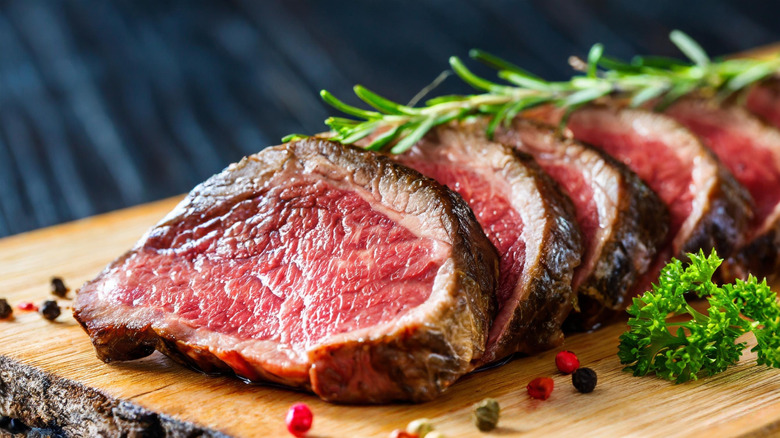For many carnivores, a good steak represents one of life’s simple pleasures. But not all steaks taste the same. Over the past couple of decades, grass-fed beef has gained popularity for its leaner nutritional profile and perceived ethical and environmental benefits. However, when biting into a grass-fed steak, the difference in taste and texture compared to conventional grain-fed beef is immediately noticeable. So why exactly does grass-fed beef taste different?
The Diet Makes a Difference
Cattle evolved as grazing animals, naturally feeding on grass However, in conventional agriculture, cattle destined for beef production spend the majority of their lives eating cereal grains like corn and soy after being weaned from their mothers’ milk This intensive “finishing” stage for the last few months of their lives changes the flavor profile of the meat.
Grain finishing leads to well-marbled beef, with thin white lines and flecks of fat distributed throughout the meat This marbling provides flavor, a creamy texture, and juiciness when cooked The grain diet also imparts a mildly sweet taste. Grass-fed cows instead dine on grass and other forage their whole lives. Without the concentrated calories from grain, their beef has a leaner fat content and more pronounced flavor. The taste is often described as mildly gamey or grassy.
Less Fat Means Less Flavor
The reduced marbling and overall lower fat content of grass-fed beef impacts its taste Fat carries a lot of beef’s signature rich, meaty flavor Without as much fatty marbling, grass-fed beef can have a slightly blander taste. The fat present has a different composition compared to grain-fed beef, which some find more flavorful. But with less total fat, grass-fed beef may also come across as drier and chewier when cooked.
Nutrition Profile Favors Grass-Fed
While fattier grain-fed beef may be more succulent and tender, grass-fed beef offers some nutritional advantages. It is lower in calories by virtue of having less fat. Grass-fed beef also contains higher levels of heart-healthy omega-3 fatty acids compared to grain-fed. Conjugated linoleic acid (CLA), another type of fatty acid linked to health benefits, is also twice as high in grass-fed beef.
Finishing Matters for Flavor
Not all grass-fed beef is equal when it comes to taste. Beef from cattle that were well-finished, meaning allowed to fatten up on high-quality pasture, offers better flavor. Genetics also play a role, as some breeds are optimized for grass-feeding more than others. The age of the animal and duration of grass-finishing impacts taste too. Beef from an older cow, like 5-10 years old, that was grass-fed for multiple years will have a different eating experience over beef from a younger conventionally raised cow finished on grass for a shorter time.
Cooking Tips for Grass-Fed Beef
Since it has less marbling, grass-fed beef cooks faster and can become dry and tough if overcooked. Steaks should be cooked rare to medium-rare, and roasts benefit from slow, moist cooking methods like braising. Adding extra moisture in the form of oils, butter, or marinades compensates for the leanness. Smothering burgers with flavorful toppings also prevents dryness. Grass-fed beef requires a delicate hand to cook properly and highlight its distinctive flavor rather than becoming tough.
The Verdict?
The difference ultimately comes down to personal taste. While fattier, buttery grain-fed beef may be more appealing to some, the unique flavor of grass-fed beef has its dedicated fans. Grass-fed also offers some advantages for health-conscious consumers. For the optimal eating experience, seek out high-quality grass-fed beef from cattle bred specifically for grass finishing. The meat should be well-marbled and properly aged. And grass-fed beef requires slightly different cooking techniques to showcase its flavors and textures at their best. The next time you bite into a grass-fed burger or steak, savor the flavor differences from conventional beef.

Grain vs. Grass Finished
Diet is one of the most influential factors that impacts beef flavor and aroma. This is because the dietary nutrients cattle consume directly impact the fatty acid profile and nutrient profile of their fat. One of the most-common mantras in the meat industry is that fat is flavor. Most of the beef produced in the United States is grain finished, and many American consumers prefer the flavor of grain finished beef. While the demand for grass-finished beef, also called grass-fed, has been increasing, it would still be considered a niche market in the United States. Grass-finished beef may also look different than grain-finished, as the meat is generally leaner, the fat tends to be more of a yellow color, and the lean a darker red. However, in countries like Brazil and Australia, grass-finished beef is the norm and is generally preferred to grain-finished.
Joe Rogan – Which is Better: Grass-Fed or Grain-Fed Beef?
FAQ
Why does my grass-fed beef taste weird?
Because they haven’t been plumped up with fat from grain and have space to roam and use their muscles, unlike in feedlots, the beef’s flavor is slightly …Jan 4, 2025
Does grass-fed beef taste better or worse?
While grass-fed beef is healthier and generally tastes better, there are other factors to consider that affect the way your steak tastes. The cut is a prime example. Certain cuts are fattier, tastier, and some beef eaters just prefer certain cuts over others.
What are the downsides of grass-fed beef?
The disadvantage are that the animals are going to be exposed to environmental factors being that they’re out on pasture, including the wind, et cetera. This can affect their growth rate and mean that it takes them a longer time to finish.
Does eating grass-fed beef make a difference?
When compared to feedlot, grain-fed beef, naturally raised grass-fed meat contains three times more omega-3, seven times more vitamin A, and ten times more vitamin E. Grass-fed beef is also significantly higher in carotenoids and other antioxidants, and is lower in total fat and calories.
